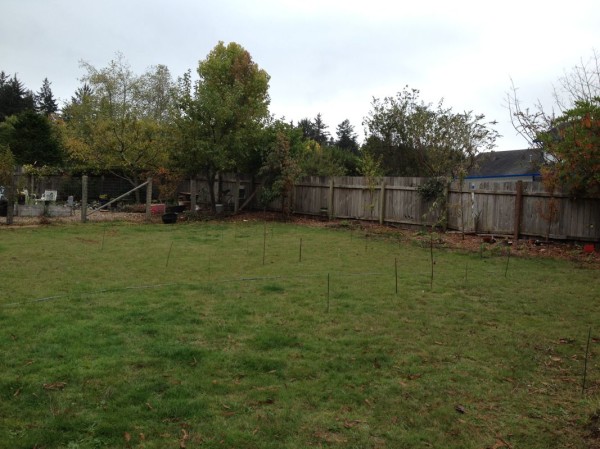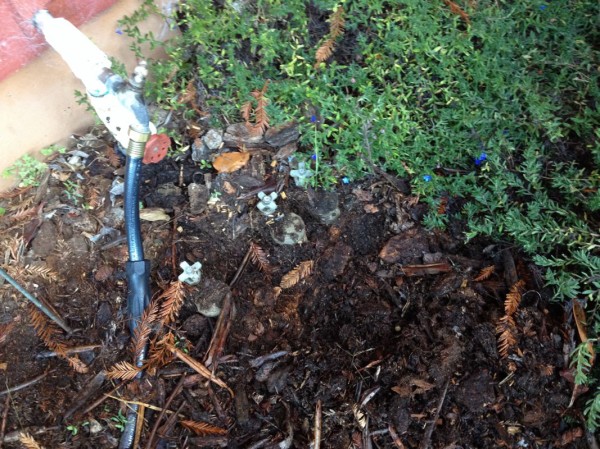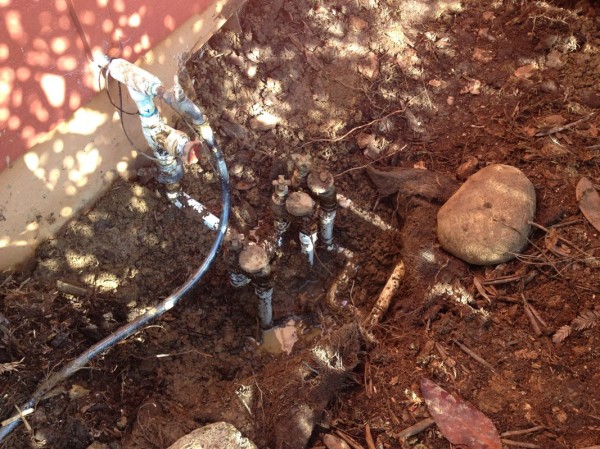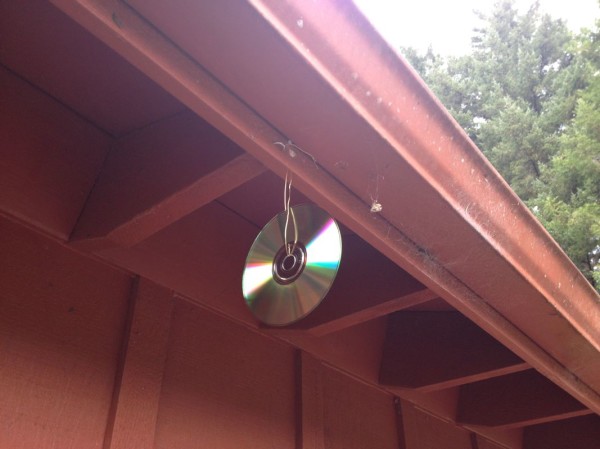Journal #5: Slow Progress and Dead Birds
by Miles Raymer
The last two weeks have brought some slow progress, but we are still a few weeks away from anything big. One of our most immediate projects is to double the size of our vegetable garden. We want to put in a new pond, at least five new 12′ by 3′ raised beds, and a 8′ by 12′ greenhouse. Our current beds were built on a slight slope, which made the construction process more difficult, so in this expansion we’re going to level the space for the new garden. Since the backyard has a slight slope with a northern aspect, we are going to pull some of the topsoil from the southwest corner down into the northeast corner. Until we can get someone to bring a tractor in for a few hours, we can’t begin constructing the beds or digging the new pond. This week, Ma and I used small bamboo stakes to mark where we want everything to go. The positioning is still rough, but it feels good to have a picture in my mind of what it will look like. After some thinking, I realized that we planned something for almost all the new space. Remembering the importance of creating planned redundancies to mitigate unforeseen developments, I suggested that we push the location of the new fence out an extra 15 feet or so, which will provide additional, unplanned garden space for future projects. Not sure what we will do with it, but that’s the point I suppose!
One concern about this project is that we have an old sprinkler system in the lawn that was originally installed by the family that built our house. We haven’t used the sprinklers in years, but we know the pipes are still in the ground. In an attempt to learn more about how the system works and where exactly the pipes might be located, I tried to turn the system on, but found that it no longer functions properly. The spigots have corroded to the point where they leak quite a lot, so I’m assuming there isn’t adequate water pressure. So I decided to walk the lawn in search of the old sprinkler heads that used to pop out of the earth a few times a year. It brought back fond memories. We never used the sprinklers to irrigate the lawn, but we did turn them on from time to time so my sister and I could run through them to cool off on hot summer days. I was only able to locate one old sprinkler head, which luckily is not located in new garden area. However, Ma and I are convinced that at least two or three more sprinklers remain undiscovered. Realizing that I should probably learn as much about the setup as I can, I decided to dig up the area where the spigots are located and take a look at the piping.
It was mucky work, and I had to be careful not to damage any of the pipes, but I eventually got deep enough to reveal the basic layout.
It’s difficult to see in this picture, but the system diverts water into one pipe that goes all the way out to the garden (for hose irrigation), with three other pipes that go to the sprinklers, each of which is controlled by a different spigot, now corroded. It doesn’t seem very complex, but given my total lack of experience with this sort of thing, I found it fascinating! I am still in the process of attempting to locate the old sprinkler heads and track these pipes to their final destinations beneath the lawn, but for now I have a bit of a better idea of how the system is put together. I’m no longer convinced that the pipes will present a significant problem for whomever comes to level the ground, but am continuing to investigate as part of my PATO.
Sometimes I’m anxious to get started on the new garden, but I also know that once the ground is level there will be so much work to do that it will sometimes feel overwhelming; it’s a little like staring out of an open airplane hatch, waiting for someone to bring me my parachute. While I wait, there are many small projects keeping me busy. The first of which is to learn the basics of botany. While I am still unsure about how effective self-teaching will be, I’m going to do my best to learn the basics. I’m also considering trying to sit in on a botany class or two at Humboldt State University if I feel like I need a more formal environment. I am using Tomas J. Elpel’s Botany in a Day: The Patterns Method of Plant Identification. The folks at OAEC recommend the book, and so far it has been very useful. I’ve only gone so far as to review some of the basic information that I can dimly remember from elementary school. I went outside and picked a few flowers, one of which I believe was a rhododendron (I am not nearly at the point where I could begin identifying particular species). It was a lot of fun to pull the delicate flowers apart and identify the different elements, such as pistils, stamens, petals, and sepals. I learned the difference between monocot and dicot/eudicot flowering plants, as well as the characteristics of simple and specialized flowers. I feel completely out of my comfort zone studying this stuff, but it also brings out in me a sense of childish wonder that I haven’t felt in a long time. It’s similar to how I felt when I planted my winter greens. In the next few weeks I will begin teaching myself about various plant families.
Other endeavors include continuing to take care of my worm farm, which seems to be going well. I watch the moisture levels carefully and am trying not to overfeed them (apparently this is a common mistake when starting a worm farm); so far the little worms seem happy and healthy. I also spent some time last week cleaning out our garden pond, which was a very chilly affair. I’m mulching various edges around the garden and porch in the attempt to enrich the soil for our many perennial plants. The winter garden is flourishing. I might lose a few of the smaller plants, but I generally I think this first attempt at growing will prove a success.
The last thing I’d like to report is a peculiar experience I had with birds. Twice in the last two weeks, a small bird accidentally flew into one of our sliding doors. Whenever this happens, the birds almost always die or become seriously injured. The first broke its neck and died very quickly; I held it as its little heart slowly stopped. The second bird seemed okay at first, but after a few moments I realized it was unable to take flight. I tried to help it get airborne, but each time it flapped ineffectively and fell back to earth. Thinking I didn’t have any other choice, I broke the bird’s neck to spare it the experience of being killed by my dog or some other predator. It felt like the right thing to do at the time, but it was very difficult for me. Moments after disposing of the carcass, I found myself crying in Jessie’s arms. The accidental, pointless nature of this creature’s death was overwhelming. Even worse, I ended up telling Shail at Tule Fog Farm about the experience, and she said that it’s possible the bird was just stunned and that it might have been able to fly again if I’d given it more time to recover. Needless to say, I was appalled at my hasty decision to kill the bird before I really had an idea of what was wrong. In the moment, it seemed merciful, but now I realize that I was trying to get the whole thing over with as quickly as possible. I was uncomfortable, which led me to unconsciously put my own needs before that of the injured animal. What felt like pragmatic compassion turned out to be nothing more than selfish haste. With more patience, perhaps the bird would have had a chance. I’m not proud of my actions.
This experience helped me reflect on the intimate nature of killing animals firsthand. I recently went to see Peter Singer, the famous philosopher and author of Animal Liberation, speak at HSU. In his discussion of factory farming he demonstrated just how distanced we have become from the process by which we acquire most of the meat we consume. I’m not a vegetarian, but I strongly believe that animals raised for meat deserve a comfortable, healthy life. It’s interesting and not a little disingenuous that I have no problem eating chicken at a restaurant but fall apart emotionally when I partake in the death of one small bird. I am a long way from resolving my personal feelings on this matter, but I know my reaction has something to do with the fact that the bird’s death was unplanned and premature. That’s not to say that many farmed animals don’t have a similar experience (and much worse), but simply to identify one aspect of my emotional reaction to the event. Tule Fog is having a turkey slaughtering on the Sunday before Thanksgiving, so I’m definitely going to attend in an effort to further delve into my feelings on this matter. It’s still an unsolved quandary. For now, I hung some CDs over our glass doors in an effort to prevent future unnecessary loss of life.



